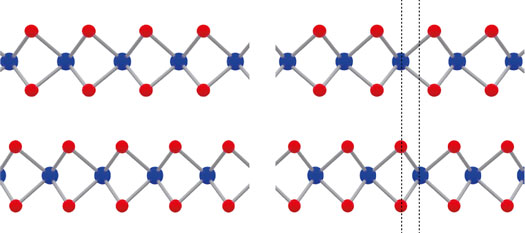| Posted: Sep 26, 2014 |
Exploring the potential of 'valleytronics'
|
|
(Nanowerk News) Yoshihiro Iwasa and colleagues from the RIKEN Center for Emergent Matter Science, the University of Tokyo and Hiroshima University have discovered that ultrathin films of a semiconducting material have properties that form the basis for a new kind of low-power electronics, termed ‘valleytronics’ ("Valley-dependent spin polarization in bulk MoS2 with broken inversion symmetry").
|
 |
| The positions of atoms in conventional few-layer molybdenum disulfide are mirrored from one layer to the next (left). Molybdenum disulfide in which each layer is displaced from the one below (right) has great potential for 'valleytronics'.
|
|
Electronic components store, transmit and process information using the electrical charge of an electron. The use of charge, however, requires physically moving electrons from one point to another, which can consume a great deal of energy, particularly in computing applications. Researchers are therefore searching for ways to harness other properties of electrons, such as the ‘spin’ of an electron, as data carriers in the hope that this will lead to devices that consume less power.
|
|
Valleytronics is based on the quantum behavior of electrons in terms of a material’s electronic band structure. “Semiconductors and insulators derive their electrical properties from a gap between the highest band occupied by electrons, known as the valence band, and the lowest unoccupied band or ‘conduction band’ in the band structure,” explains Iwasa. “If there are two or more dips in the conduction band or peaks in the valence band, we say that the band structure contains valleys.”
|
|
Using this valley property of electrons to encode information without physically moving electrons is the central tenet of valleytronics. Iwasa and his co-workers combined theoretical calculations with an experimental spin- and angle-resolved photoelectron spectroscopy technique to identify such valleys in the band structure of an ultrathin layer of molybdenum disulfide just a few atoms thick.
|
|
Molybdenum disulfide is a member of a family of materials known as transition metal dichalcogenides, which are currently the focus of intense research because of the unusual electronic properties they display when prepared in two-dimensional layers. Iwasa and his team created films consisting of one to four atomic layers of molybdenum disulfide. Most previous studies of this material focused on films in which each layer is the mirror image of the one below. Instead, the atoms in each molybdenum disulfide layer in the films created by Iwasa’s team were slightly shifted from those in the two-dimensional level beneath (Fig. 1). This breaking of the film’s symmetry meant that the researchers were also able to harness the spin of electrons. “We uncovered strong coupling between the valley and spin degrees of freedom,” says Iwasa.
|
|
The researchers hope to demonstrate valleytronics prototypes based on molybdenum disulfide and to explore other materials with valleytronic functions in order to expand the frontier of valleytronics.
|

